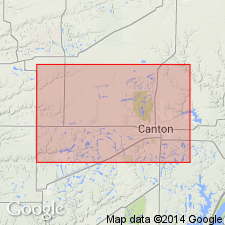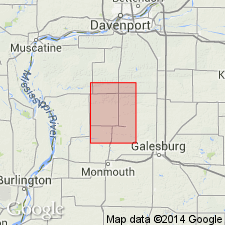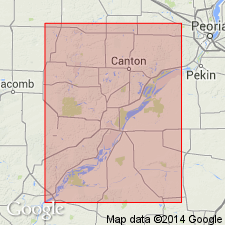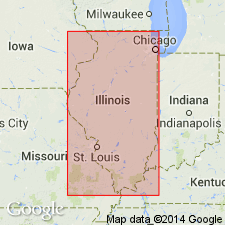
- Usage in publication:
-
- Francis Creek shale and limestone
- Modifications:
-
- Original reference
- Dominant lithology:
-
- Shale
- Limestone
- AAPG geologic province:
-
- Illinois basin
Summary:
Pg. 309. Francis Creek shale and limestone. 0 to 65 feet thick in Fulton County, central western Illinois. Rests on Colchester (No. 2) coal and unconformably underlies Vergennes sandstone in Fulton County. Age is Pennsylvanian.
Source: US geologic names lexicon (USGS Bull. 896, p. 769).

- Usage in publication:
-
- Francis Creek shale
- Modifications:
-
- Revised
- Dominant lithology:
-
- Shale
- AAPG geologic province:
-
- Illinois basin
Summary:
Pg. 49, 89. Francis Creek shale [restricted] in Carbondale formation. In Alexis quadrangle [chiefly in Mercer County, central western Illinois] consists of 0 to 9 feet of soft gray shale resting on Colchester (No. 2) coal, and lying 21+/- feet below Pleasantview sandstone, all included in Carbondale formation. The name Francis Creek has been applied (Savage, 1927) to all strata of suite IV above Colchester (No. 2) coal, because they are well exposed along Francis Creek, Fulton County, Illinois, but the cited type exposure does not well exhibit the upper members of the suite, and so it is proposed that name be applied only to the soft gray shale between the coal and the black laminated concretionary shale (1 foot thick) in lower part of Carbondale formation. Age is Pennsylvanian.
Source: US geologic names lexicon (USGS Bull. 896, p. 769).

- Usage in publication:
-
- Francis Creek shale
- Modifications:
-
- Principal reference
- Revised
- AAPG geologic province:
-
- Illinois basin
Summary:
Pg. 50 (fig. 22), 88-89, 203. Francis Creek shale of Carbondale group. Thickness 40 to 45 feet near Lewistown and near type locality; 65 feet near Colchester. Shale is wholly or partially truncated in areas of Pleasantview sandstone channels replaced by Jake Creek sandstone (new) in southern part of Vermont quadrangle. Included in Liverpool cyclothem where it occurs below the Jake Creek sandstone and above Colchester (No. 2) coal. Age is Pennsylvanian. Type locality given.
Type locality: roadcut on west side of Francis Creek, in NE/4 SW/4 sec. 22, T. 5 N., R. 1 E., Vermont quadrangle, Fulton Co., western central IL.
Source: US geologic names lexicon (USGS Bull. 1200, p. 1417).

- Usage in publication:
-
- Francis Creek shale member
- Modifications:
-
- Revised
- AAPG geologic province:
-
- Illinois basin
Summary:
Pg. 35, 46 (table 1), pl. 1. Francis Creek shale member of Carbondale formation of Kewanee group (new). Occurs about Colchester (No. 2) coal member and below Jake Creek sandstone member. Age is Pennsylvanian. Presentation of new rock-stratigraphic classification of Pennsylvanian strata of Illinois.
Source: US geologic names lexicon (USGS Bull. 1200, p. 1417).
For more information, please contact Nancy Stamm, Geologic Names Committee Secretary.
Asterisk (*) indicates published by U.S. Geological Survey authors.
"No current usage" (†) implies that a name has been abandoned or has fallen into disuse. Former usage and, if known, replacement name given in parentheses ( ).
Slash (/) indicates name conflicts with nomenclatural guidelines (CSN, 1933; ACSN, 1961, 1970; NACSN, 1983, 2005, 2021). May be explained within brackets ([ ]).

